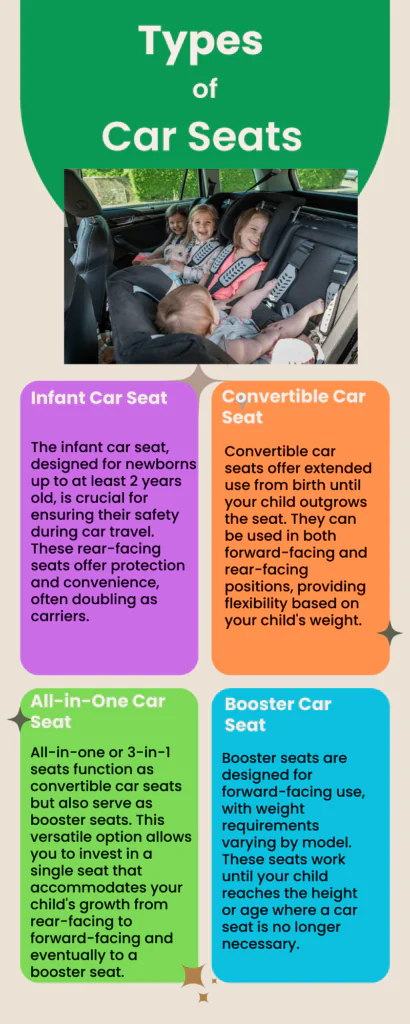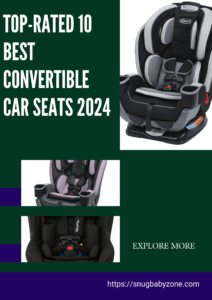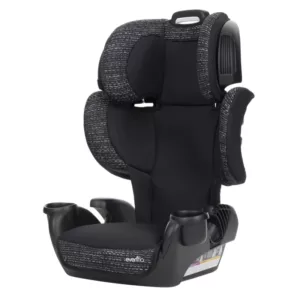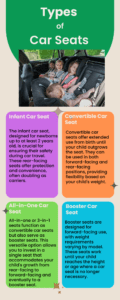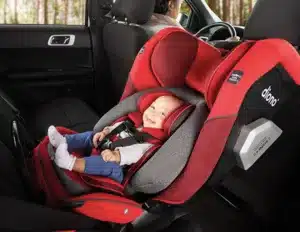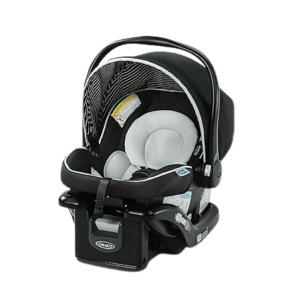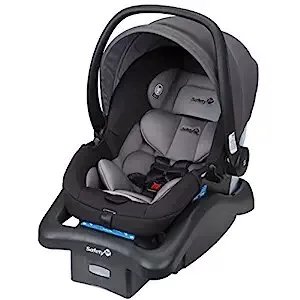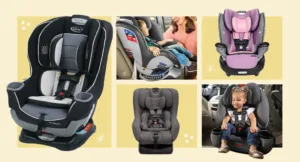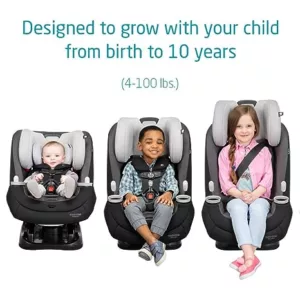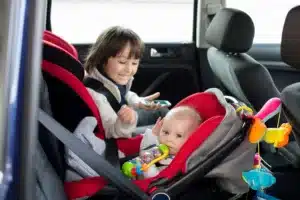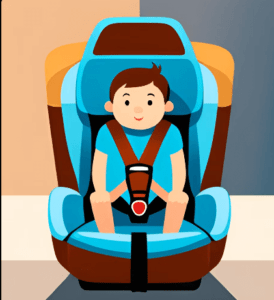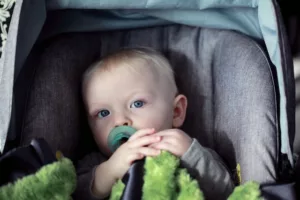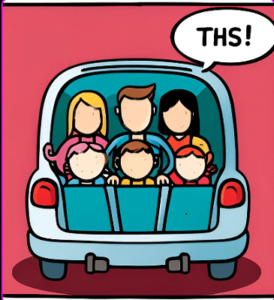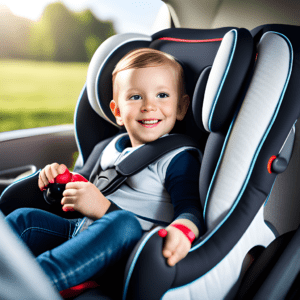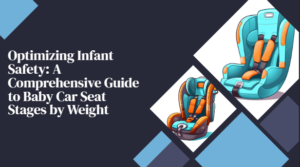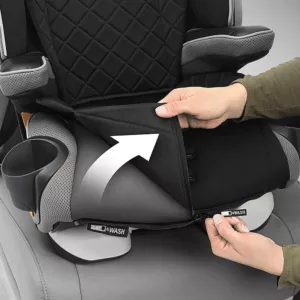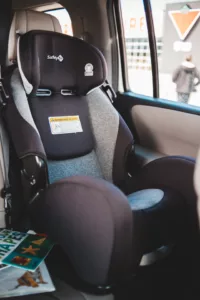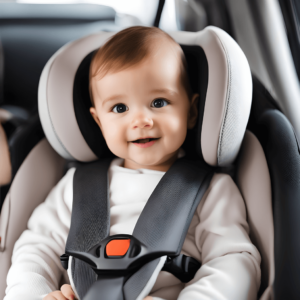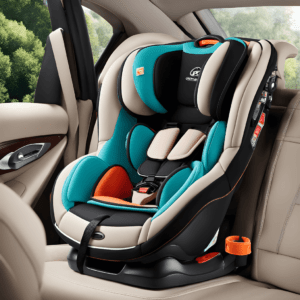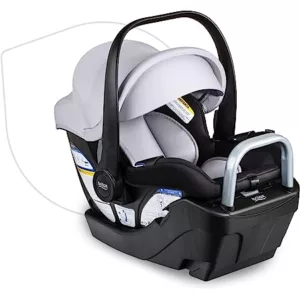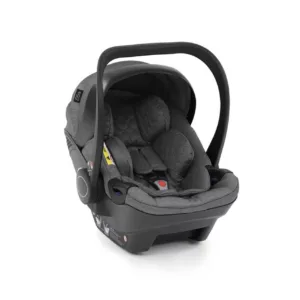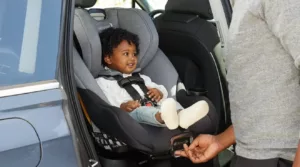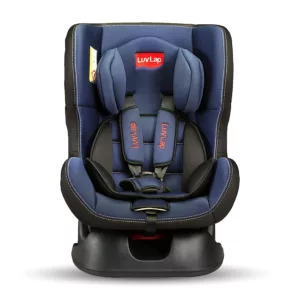Did you know that car crashes are a leading cause of death for children under 13?
Thank you for reading this post, don't forget to subscribe!Scary, right? But the good news is that using the right car seat can greatly reduce the risk of injury or death in a crash. That’s why choosing the right car seat for your child’s age, weight, and height is important. And don’t worry; we’ll guide you through all the different types of car seats available:
Table of Contents
ToggleWhat are the 4 Types of Car Seats?
There are 4 types of baby car seats:
- Infant Car Seats
- Convertible Car Seats
- All-in-One Car Seats
- Boosters Car Seats
Infant Car Seats
- Features: Designed for newborns to at least 2 years old.
- Weight/Height Limit: Typically accommodates up to 22-35 pounds and 29-32 inches in height.
- Position: Rear-facing.
- Additional Info: Can also function as a carrier. Check the National Highway Traffic Safety Administration (NHTSA) recommendations for rear-facing duration.
- Comfort Features: Plush padding, soft fabrics, adjustable headrests, and harness for a snug fit.
- Installation Method: LATCH system or seat belt installation following manufacturer’s instructions.
Convertible Car Seats
- Features: Suitable for infants up to when your child outgrows the seat.
- Weight/Height Limit: Can be used in both forward-facing and rear-facing positions, typically up to 40-50 pounds and 40-54 inches in height.
- Position: Depends on the child’s weight; rear-facing for infants and forward-facing for older children.
- Comfort Features: Plush padding, adjustable headrests, and harness for comfort as the child grows.
- Installation Method: LATCH system or seat belt installation following manufacturer’s instructions.
- Additional Info: Offers extended use, providing flexibility as your child grows.
All-in-One Car Seats
- Features: Combines features of convertible car seats with booster seat capabilities.
- Weight/Height Limit: Rear-facing: 5-40 pounds, Forward-facing: 20-65 pounds or more, Booster: 40-120 pounds or more.
- Position: Rear-facing, forward-facing, and booster.
- Comfort Features: Plush padding, adjustable headrests, and harness for comfort during different stages.
- Installation Method: LATCH system or seat belt installation following manufacturer’s instructions.
- Additional Info: A cost-effective solution as it covers multiple stages of your child’s growth.
Booster Car Seats
- Features: Designed for forward-facing use.
- Weight/Height Limit: Typically for children 4 years and older, weighing 40-120 pounds or more. Height limits typically range from 34-57 inches.
- Position: Forward-facing.
- Safety Recommendations: Use booster until at least 8 to 12 years old or tall enough for proper seat-belt fit.
- Comfort Features: Padded seating and armrests for comfort during longer rides.
- Installation Method: Utilises the vehicle’s seat-belt for restraint, ensure proper positioning for secure travel.
- Additional Info: Works until your child is old enough to use a seatbelt. Follows evolving state laws regarding weight requirements.
A Detailed Over View of 4 Types of Baby Car Seats
Infant Car Seats
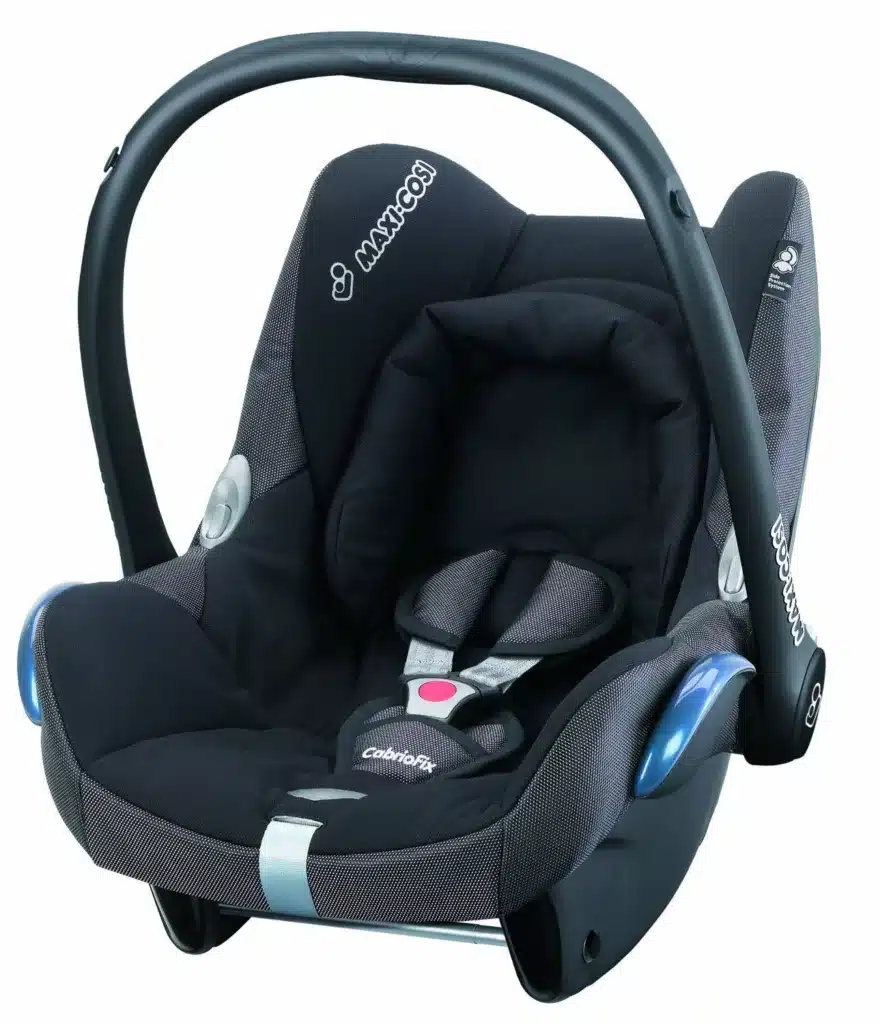
An infant car seat is one of the 4 types of baby car seats, specifically designed to cater to the needs of newborns and infants, providing them with the utmost safety and comfort during car journeys. It is typically rear-facing, the safest position for infants, providing crucial support for their head, neck, and spine during a collision.
Comfort is a crucial aspect of infant car seats, as babies spend significant time in their car seats during travels. Quality infant car seats have plush padding, soft fabrics, and comfortable harnesses to keep the baby cosy and secure throughout the ride. Adjustable headrests and harness height ensure the car seat can grow with the child, providing a snug and supportive fit.
Safety is the top priority of these types of baby car seats. These types of baby car seats have features such as a 5-point harness system that keeps the baby securely restrained, side-impact protection, and EPS foam or energy-absorbing materials to mitigate the impact forces during a collision. Ensuring the car seat is correctly installed is critical for its effectiveness. The NHTSA recommends using the LATCH system or seatbelt to install the car seat securely, following the manufacturer’s instructions carefully.
Designed for portability, infant car seats offer ease of transport, with a detachable base that remains in the vehicle for easy installation and removal.
Convertible Car Seats
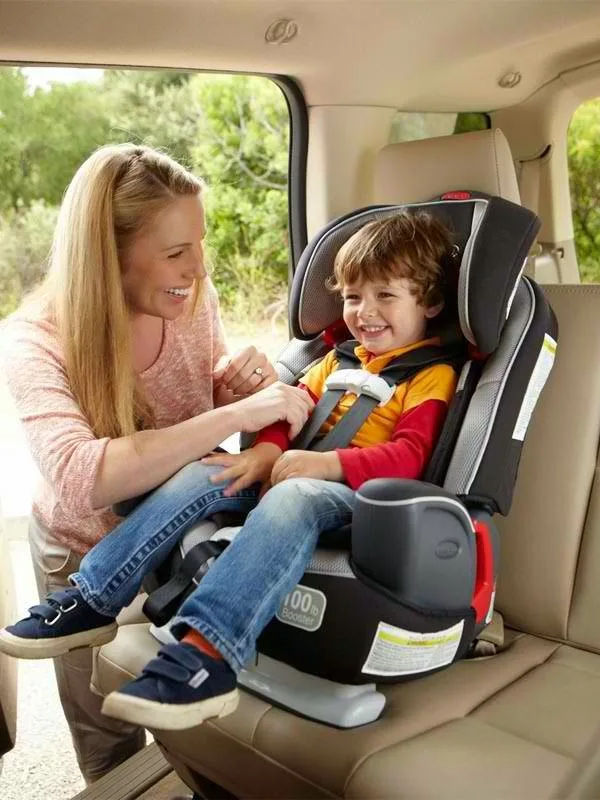
A convertible car seat is one of the versatile and long-lasting option among 4 types f baby car seats, that can adapt to different stages of a child’s growth, accommodating both rear-facing and forward-facing configurations. These types of car seats are designed to cater to infants and young children, offering extended use and value to parents.
Comfort is an essential aspect of a convertible car seat. These car seats are equipped with plush padding, soft fabrics, adjustable headrests, and harness height to provide a comfortable and secure fit for the child as they grow.
Safety features in convertible car seats include:
- A 5-point harness system that keeps the child securely restrained.
- Side-impact protection.
- Energy-absorbing materials to mitigate crash forces.
Like infant car seats, convertible car seats follow the NHTSA’s safety guidelines for proper installation. Parents can use the LATCH system or seatbelt to install the car seat securely in the rear-facing or forward-facing position, following the manufacturer’s instructions carefully.
These types of baby car seats offer the flexibility to be used in both rear-facing and forward-facing positions, making them suitable for infants and toddlers alike. They typically have multiple recline positions to ensure a proper angle in both configurations, providing crucial support for the child’s head and neck.
All-in-One Baby Car Seats

An all-in-one car seat, also known as a 3-in-1 car seat, is a comprehensive option that offers multiple configurations to accommodate children from infancy to booster seat age.
These versatile types of baby car seats accommodate various stages of a child’s growth, serving rear-facing seat for infants, a forward-facing seat for toddlers, and later transforming into a high-back or backless booster for older children.
Comfort is an essential aspect of an all-in-one car seat. These types of baby car seats come with plush padding, soft fabrics, adjustable headrests, and harness height to provide a comfortable and secure fit for the child throughout their different stages of growth.
Safety features in all-in-one car seats include a 5-point harness system for rear-facing and forward-facing configurations, side-impact protection, and energy-absorbing materials. When used as a booster, the car seat should have belt-positioning guides to ensure that the vehicle’s seat belt fits properly across the child’s lap and shoulder.
Like other car seats, all-in-one cars follow the NHTSA’s safety guidelines for proper installation. Parents can use the LATCH system or seat belt to install the car seat securely in the rear-facing or forward-facing position, following the manufacturer’s instructions carefully.
These types of baby car seats offer the advantage of being a single purchase that can serve the child from infancy to booster seat age, making them a cost-effective and long-lasting choice for families.
A Booster Car Seat
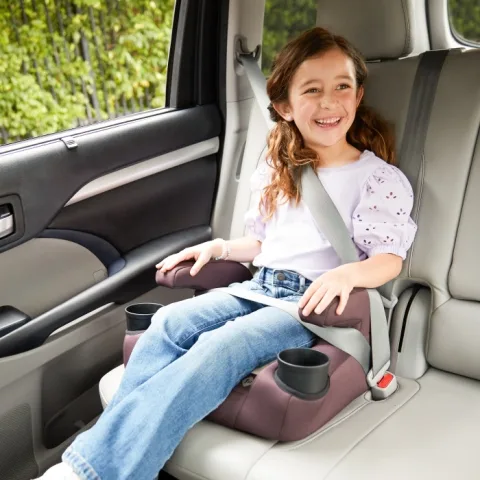
A booster car seat is designed for older children who have outgrown forward-facing car seats but have yet to be ready to use the vehicle’s seat belt alone. Boosters elevate the child to a proper height, ensuring that the seat belt fits correctly across their body.
Safety features in booster seats include belt-positioning guides that help correctly position the vehicle’s seat belt across the child’s lap and shoulder. Some high-back booster seats also support the head and neck, especially for children who fall asleep during car rides.
These types of baby car seats do not have a harness system like rear-facing or forward-facing car seats. Instead, they rely on the vehicle’s seat belt for restraint.
Rear-facing and front-facing configurations do not apply to booster seats, as they are used solely with the vehicle’s seat belt. However, some booster seats may offer the option to use them with a high back or as a backless booster, depending on the child’s size and preference.
Baby Car Seat Stages Based on Weight
| Car Seat Stage | Weight Range | Description |
| Infant Car Seat | Birth to 22-35 pounds (10-15.9 kg) | Provides support for newborns and infants. |
| Convertible (Rear-Facing) | Birth to 40-50 pounds (18.1-22.7 kg) | Offers extended rear-facing protection. |
| Convertible (Forward-Facing) | Around 22-40 pounds (10-18.1 kg) | Allows forward-facing travel with safety features. |
| Booster Seat | 40-80 pounds (18.1-36.3 kg) and up | Raises child for proper seat belt placement. |
| Regular Seat Belt | 80 pounds (36.3 kg) and above | Child can use the vehicle’s seat belt independently. |
Final Verdict
In conclusion, selecting the right car seat for your child is an essential decision that directly impacts their safety and comfort during car journeys. Infant car seats cater to the needs of newborns and infants, providing crucial support and protection in the rear-facing position.
Convertible car seats offer versatility, accommodating both rear-facing and forward-facing configurations, ensuring extended use as your child grows. All-in-one car seats provide a comprehensive solution, transitioning from rear-facing to booster seat age. Booster car seats are designed for senior kids, elevating them to a proper height for secure seat belt positioning.
When choosing, consider factors like safety features, weight and height limits, and ease of installation for all types of baby car seats. Always adhere to the NHTSA’s guidelines and the manufacturer’s instructions to ensure proper use.
With the right car seat, you can embark on every journey with peace of mind, knowing that your precious little passenger is safe, comfortable, and protected. Happy travels!
Frequently Asked Questions – FAQ
When should I transition my child from an infant to a convertible car seat?
Your child can transmit from the Infant car seat to the Convertible when they reach the maximum weight or height limit specified by the manufacturer.
How long should my child stay in a rear-facing car seat?
The child can stay in a rear-facing car seat until they reach the specified maximum weight or height limit by the car seat manufacturer.
What should I look for when purchasing a second-hand car seat?
When purchasing a second-hand car seat, look for its expiration date, ensure it has never been involved in a crash, and check for all parts and labels.
Are there car seats specifically designed for premature or low-birth-weight babies?
Yes, there are car seats specifically designed for premature or low-birth-weight babies. These car seats often have additional features like extra padding, support inserts, and adjustable harnesses to provide a snug and safe fit for smaller infants.
Choosing a car seat that meets the specific needs and requirements of premature or low-birth-weight babies is essential to ensure their utmost safety and comfort during car travel.
Read More About Types of Car Seats
Car Seat Safety Information – Explore More
Child Car Seat Types – Read This
